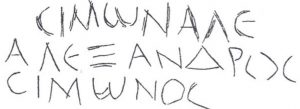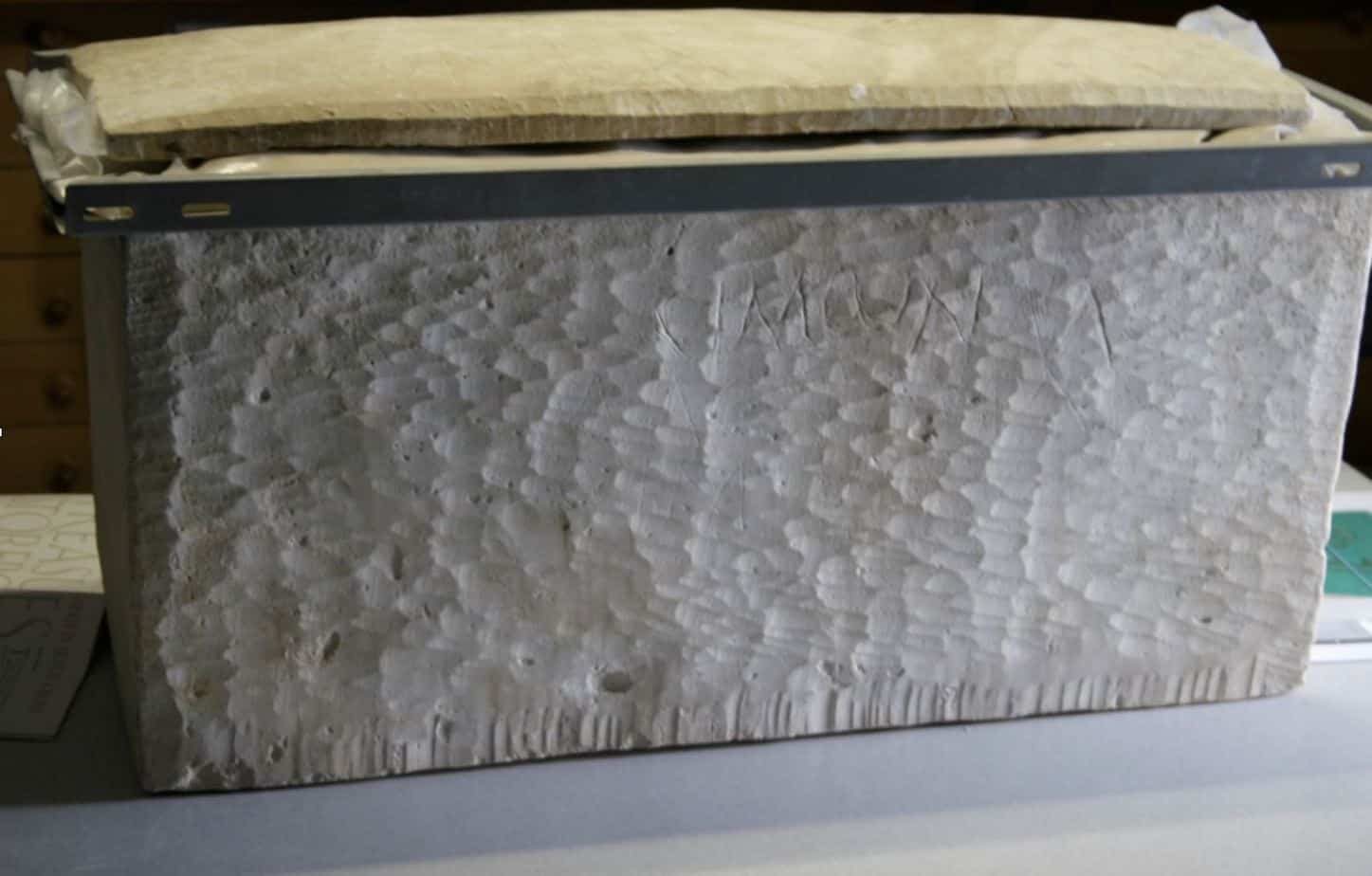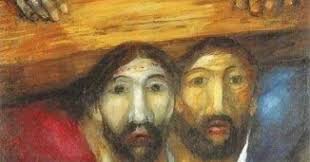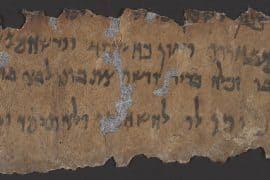The current issue of Biblical Archaeology Review has a lead feature article titled “New Testament Religious Figures Confirmed” by Lawrence Mykytiuk, as part of his fascinating series on whose identity in the Hebrew Bible and New Testament can be confirmed by extra-biblical sources–whether literary or archaeological. What Mykytiuk has done is truly remarkable–assembling this wealth of data with his acute analysis, presented in clear charts and graphs. [1]If you are not a subscriber you can join the Biblical Archaeology Society Library for a minimal fee and have access on-line to the vast collection of articles published in this and the related … Continue reading For an overview of the current magazine article you can read “Seven ‘Real’ Religious Figures form the New Testament,” online. Here is the list. This group consists of three prominent figures in the New Testament, a renowned Pharisee, and three high priests:
(1) Jesus
(2) John the Baptist
(3) James, the brother of Jesus
(4) Gamaliel the Elder
(5) Annas, son of Seth
(6) Caiaphas
(7) Ananias, son of Nebedaios
These seven figures are in addition to 23 political figures from the New Testament and 53 people from the Hebrew Bible who have been confirmed by archaeological and textual evidence in Mykytiuk’s earlier articles [2]See See Lawrence Mykytiuk, “Archaeology Confirms 50 Real People in the Bible,” BAR, March/April 2014; Lawrence Mykytiuk, “Did Jesus Exist? Searching for Evidence Beyond the Bible,” BAR, … Continue reading
Mykytiuk excludes the “James ossuary,” noting “that although some might think this is clear archaeological evidence for the existence of James the Just, I have not included it here. Since the ossuary is unprovenanced, its authenticity—and the authenticity of its well-discussed inscription—has not been established, so it does not meet the first requirement for making an identification.” He likewise dismisses the Caiaphas tomb as well as the unprovenanced ossuary inscribed “Mariam, daughter of Yeshua‘ bar Qayafa, priest of Ma‘aziah, from Bet ’Imri” as referring to our New Testament Caiaphas with any certainty. I disagree with him on both these exclusions as I think the evidence is strong in favor of identification with our New Testament figures, but I respect the strict method he has forged for his project.
I would like to suggest another candidate–Simon of Cyrene and his son Alexander–although I realize, like James and Caiaphas, it is unlikely to fit Mykytiuk’s strict criteria. Nonetheless, it is surely worth bringing to light. I have seldom met anyone who has even heard of it, even though it was the subject of a Biblical Archaeology Review article in 2003 by Tom Powers titled “Treasures in the Storeroom.” I have titled this post “Simon of Cyrene” for identification purposes, though clearly, given the contents of this tomb, it is a family tomb that has at least ossuaries of Alexander his son and his daughter Sarah–otherwise not identified in literary sources. This tomb also represented, at the time Avigad published his article, the only example of a “Sarah” on an ossuary. Whether Simon is interred in the same ossuary as his son Alexander, which seems entirely possible from the three-fold inscription as I read it–with the patronymic in the nominative–we can not be sure. Milik though such was the case, Avigad disagreed. I might also note that the tomb contained a “Jacob” or “James”–very rare–and was the first example of that name found at the time Avigad published his article.
On November 10, 1941, a single-chamber burial cave was found just southeast of the Old City of Jerusalem in the Kidron Valley. It was excavated by Eleazar Sukenik, father of Yigael Yadin, and his assistant, young Nahman Avigad, both towering giants in the early 20th century archaeology of Jerusalem. [3]Sukenik was then well-known as the founder and head of Hebrew University’s Department o Archaeology, and several years later he was to play a key role in the acquisition of the Dead Sea Scrolls by … Continue reading Sukenik only published a short note on the tomb but much later, Avigad published a full official report on the excavation in the Israel Exploration Journal in 1962, although he expressed doubt that the ossuary of Alexander/Simon can be identified with our Simon of Cyrene in Mark. [4]See Sukenik, BASOR 88 (1942): 38. Avigad gives a complete layout and description of the tomb and its finds: AVIGAD, N. “A Depository of Inscribed Ossuaries in the Kidron Valley.” Israel … Continue reading
The entrance was sealed and the cave had not been looted. Of the eleven ossuaries inside nine were inscribed, one in Hebrew/Aramaic, another bilingual, and the rest in Greek. Archaeologists were able to determine this was a family tomb for a family of Jews from Cyrene, and it was dated to the 1st century CE. One of the eleven ossuaries was inscribed several times with the names Simon and Alexander–identified as Cyrenians. [5]Cotton et al., Corpus Inscriptionum Iudaeae/Palaestinae 1:1 no. 324, pp. 344–46. Some have questioned the reading “Cyrenian” as the last letter is unclear–either a ה or ת. It … Continue reading


Alexander of Simon

Is it likely that archaeologists have stumbled upon the family tomb of Simon of Cyrene’s son Alexander–and possibly, depending on how on reads the inscription–of Simon himself, the very one mentioned in the New Testament gospels? One might think this very possibility would be an occasion for excitement and celebration. Surely this ossuary would be on display in the Israel Museum, visited by millions of Christian tourists each year who come to see the Dead Sea Scrolls and other wonders of archaeology. Whether it can be shown to be “the” Simon and Alexander of the the gospels or not, it would surely be of interest–just as the Caiaphas ossuary is on display, as well as “Jesus son of Jospeh” and “Jude son of Jesus,” without claiming either of them belong to the family of Jesus of Nazareth. I am quite sure such an ossuary on display would draw huge crowds to the museum and would it not be better to display and discuss this fascinating artifact than leave it under a table in a back storage room at Hebrew University?
But such is not the case. In fact, it took us several weeks to even find out where it might be stored. It had been largely dismissed–and then forgotten.

We went looking for the ossuary in 2005 and finally located it with some difficulty, in a back storage room at Hebrew University on Mount Scopus in Jerusalem, under a table. It did not appear to be of any particular interest to the curator who brought it out for my team to examine. He even seemed a bit curious as to why we would have shown up with an interest in seeing it. We brought with us biblical scholar Tom Powers, who had written several articles about this intriguing ossuary but had never seen it firsthand. [6]See Tom Powers, “Treasures in the Storeroom: Family Tomb of Simon of Cyrene,” Biblical Archaeology Review (July–August, 2003): 46–51, 59, as well as “The Story of the Alexander (son of) … Continue readingHe had done all his work from published photos. We studied the bone box in great detail, photographed it, measured it, and examined it for any possible additional markings. We all felt awe in the little storage room where we were gathered that day. We had to ask ourselves, Is it possible we are standing around the ossuary that once held the bones of Alexander, Simon of Cyrene’s son? There is no Rufus in this tomb but it is worth noting that Paul mentions a Rufus in his list of greetings to the Christians at Rome–along with “his mother and mine” (Romans 16:13). Perhaps Rufus was younger, lived on, and even made his way to Rome. [7]The single inscriptional example of this Latin name, rare in Jerusalem, but known in Cyrene, was found in another tomb in 1954 in another area of Jerusalem, see Cotton, CIIP, 1:1 no. 385, pp. 405–6.

Archaeology connects us to our ancient past, but there is something about a tomb and a burial that is particularly moving. It is asy to imagine Alexander the son being present that day with his father, as Jesus passed by carrying the cross. The gospels say Simon was a passerby who was coming in from the countryside for Passover. Since the festival of Passover is a family event, his sons Rufus and Alexander would have undoubtedly been with him (Mark 15:21). Might Alexander have been present when the Roman soldiers impressed Simon to carry the cross? Would he then have followed his father to the place of execution and have even witnessed the crucifixion of Jesus? The name Simon is fairly common among Jews of this period but the name Alexander much less so—and this Alexander, like his father, is from Cyrene. That day, standing in the storeroom at Hebrew University, we were all contemplating that spine-tingling probability and experiencing firsthand the remarkable ways ancient archaeological finds can connect us to the past.









Comments are closed.